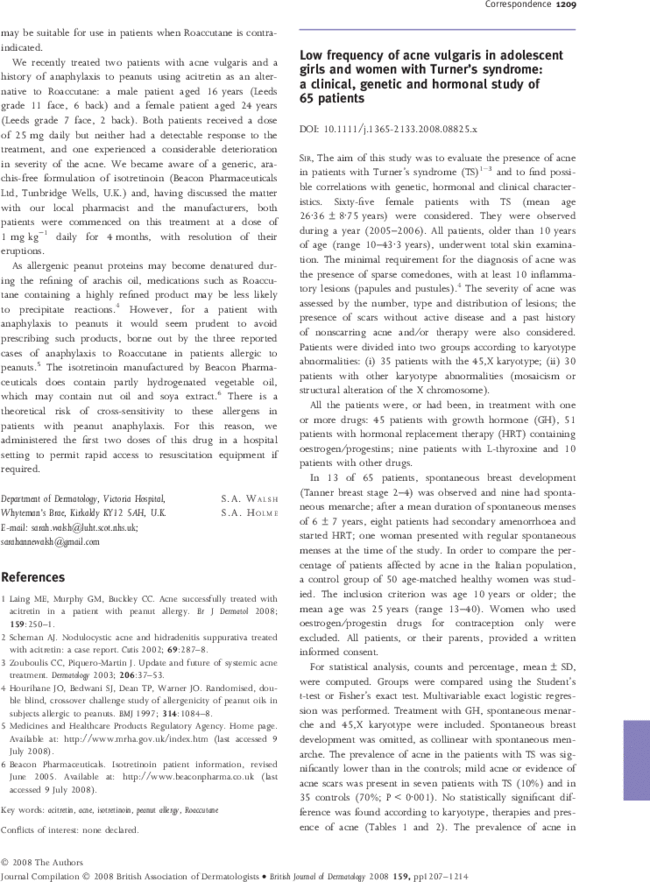Low frequency of acne vulgaris in adolescent girls and women with Turner’s syndrome: a clinical, genetic and hormonal study of 65 patients
V. Brazzelli
Departments of Human and Hereditary Pathology, Institute of Dermatology
Search for more papers by this authorF. Muzio
Departments of Human and Hereditary Pathology, Institute of Dermatology
Search for more papers by this authorL. Fornara
Departments of Human and Hereditary Pathology, Institute of Dermatology
Search for more papers by this authorC. Klersy
Clinical Epidemiology and Biometry Unit, University of Pavia and Fondazione IRCCS Policlinico S. Matteo, Piazzale Golgi 2, Pavia 27100, ItalyE-mail: [email protected] ; [email protected]
Search for more papers by this authorG. Borroni
Departments of Human and Hereditary Pathology, Institute of Dermatology
Search for more papers by this authorV. Brazzelli
Departments of Human and Hereditary Pathology, Institute of Dermatology
Search for more papers by this authorF. Muzio
Departments of Human and Hereditary Pathology, Institute of Dermatology
Search for more papers by this authorL. Fornara
Departments of Human and Hereditary Pathology, Institute of Dermatology
Search for more papers by this authorC. Klersy
Clinical Epidemiology and Biometry Unit, University of Pavia and Fondazione IRCCS Policlinico S. Matteo, Piazzale Golgi 2, Pavia 27100, ItalyE-mail: [email protected] ; [email protected]
Search for more papers by this authorG. Borroni
Departments of Human and Hereditary Pathology, Institute of Dermatology
Search for more papers by this authorConflicts of interest: none declared.

References
- 1 Gravholt CH. Epidemiological, endocrine and metabolic features in Turner syndrome. Eur J Endocrinol 2004; 151: 657–87.
- 2 Brazzelli V, Larizza D, Martinetti M et al. Halo nevus, rather than vitiligo, is a typical dermatologic finding of Turner’s syndrome: clinical, genetic, and immunogenetic study in 72 patients. J Am Acad Dermatol 2004; 51: 354–8.
- 3 Bernasconi S, Larizza D, Benso L et al. Turner’s syndrome in Italy: familial characteristics, neonatal data, standards for birth weight and for height and weight from infancy to adulthood. Acta Paediatr 1994; 83: 292–8.
- 4 James WD. Clinical practice. Acne. N Engl J Med 2005; 352: 1463–72.
- 5 Dreno B, Poli F. Epidemiology of acne. Dermatology 2003; 206: 7–10.
- 6 Paraskevaidis A, Drakoulis N, Roots I et al. Polymorphisms in the human cytochrome P-450 1A1 gene (CYP1A1) as a factor for developing acne. Dermatology 1998; 196: 171–5.
- 7 Deplewski D, Rosenfield RL. Role of hormones in pilosebaceous unit development. Endocr Rev 2000; 21: 363–92.
- 8 Thiboutot D. Hormone and acne: pathophysiology, clinical evaluation, and therapies. Semin Cutan Med Surg 2001; 20: 144–53.
- 9 Apter D, Lenko HL, Perheentupa J et al. Subnormal pubertal increases of serum androgens in Turner’s syndrome. Hormone Res 1982; 16: 164–73.
- 10 Gravholt CH, Svenstrup B, Bennett P, Christiansen JS. Reduced androgen levels in adult Turner syndrome: influence of female sex steroids and growth hormone status. Clin Endocrinol 1999; 50: 791–800.




